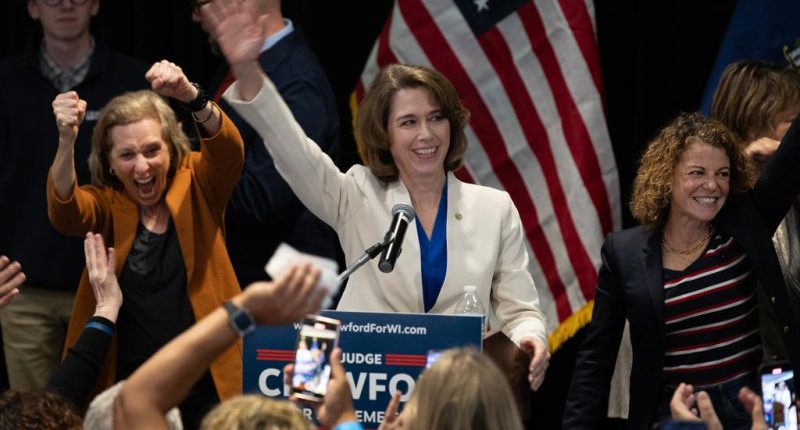
Break out the big blue hype machine: Democrats and their media allies are swooning over Tuesday’s special election results in Wisconsin and in Florida.
They’re saying this is the start of the turnaround, a sign that people are rebelling against President Donald Trump and Elon Musk.
A party badly in need of a jolt got one, and best of all they got it the old-fashioned way: By beating up on the big bad orange man.
It’s a great story.
There’s only one problem: It isn’t true.
Oh, it’s true that Republican candidates ran well behind Trump in the key races.
Florida’s two new GOP congressmen, Jimmy Patronis and Randy Fine, won by 14 and 15 percentage points in districts that Trump carried by 37 and 30 points, respectively.
Brad Schimel, the GOP-backed candidate for Wisconsin Supreme Court, also trailed Trump by double digits.
Trump carried the Badger State by about a point in 2024, while Schimel lost by 10.
The problem with the Democrats’ tale is that they’ve willfully misunderstood why these outcomes occurred.
The Democratic coalition has shifted a lot in the Trump era.
The party used to represent less-educated voters who were less engaged in politics, while Republicans tilted to the elites.
Now that’s reversed: Democrats do best with highly educated voters who are highly engaged with politics, the people who vote all the time.
Today, it’s the GOP coalition that’s tilted toward voters who only come out for general elections.
The lower the turnout, the more likely it is that Democrats will overperform compared to their presidential result.
The Florida seats are proof of this.
The composition of the electorates for the two specials was between five and 10 points less Republican than it was last November.
Adjusting for that reality substantially reduces the degree of Democratic overperformance.
Tuesday’s electorates likely tilted even further away from the GOP when we consider registered independents.
These voters lean toward one party, but are much less engaged with politics — and tend to avoid special elections.
Republican-leaning registered independents may be even less likely than Democratic-leaning indies to vote in special elections.
If so, that would explain even more of the Democrats’ supposed overperformance.
The electorate for Wisconsin’s April election has long tilted left.
Liberal areas, especially ultra-progressive Madison (Dane County) and its suburbs, accounted for a significantly higher share of the electorate in 2023’s April court election than in either the 2022 or 2024 general elections.
That happened again Tuesday: NBC’s Steve Kornacki reported that turnout as a share of the 2024 presidential vote was 11 points higher in Dane County than in Wisconsin’s largely rural, pro-Trump areas.
That shift alone likely accounts for a substantial amount of Democrat-backed Susan Crawford’s improvement over Kamala Harris’ result — an advantage that will evaporate next fall when less engaged, pro-Trump voters habitually turn out.
There’s a great example of how this works from 2022, when an August special election for New York’s 19th congressional district saw Democrat Pat Ryan beat Republican Marc Molinaro on a low turnout of only 129,000 voters.
Molinaro ran for a similar congressional seat (the old one had been redistricted) that November.
This time he won, doing notably better in the four counties included in both districts.
In Sullivan County, the Republican’s margin improved from 15 to 20 points as turnout more than doubled.
Molinaro’s Delaware County margin jumped from 17 to 24 points, and he carried Greene County by a point more than he had in August.
Molinaro even improved in Columbia County, a Democratic bastion he lost by 15 points in the summer but by only 10 in the fall.
There’s absolutely no reason to think that pattern won’t repeat in this cycle.
Midterm elections are largely presaged not by special election results, but by the incumbent president’s job approval rating.
In 2022, for example, Democrats won 94% of the vote among those who approved of Joe Biden’s job performance — and only 12% among those who did not.
Those figures would produce a good night for Republicans if the midterms were held today, with Trump’s 48% job approval in the RealClear Politics average (50% disapprove).
If those figures hold in November 2026 and the GOP does as well as Democrats did in 2022, Republicans will get 51% of the House vote — and likely retain their slim majority.
That would be an historic outcome, and Trump’s job approval rating may well decline over the next year and a half.
But presidential approval is the number we should be looking at, not special election results.
Kool-Aid is a tasty drink. You should have some if you want to quench your thirst on a hot summer’s day.
Downing it is a bad idea, though, if you’re a political analyst or a party strategist.
Republicans should resist the temptation to drink the Kool-Aid of electoral despair Democrats are pressing on them — and focus instead on keeping the promises that won them the White House.
Henry Olsen, a political analyst and commentator, is a senior fellow at the Ethics and Public Policy Center.






